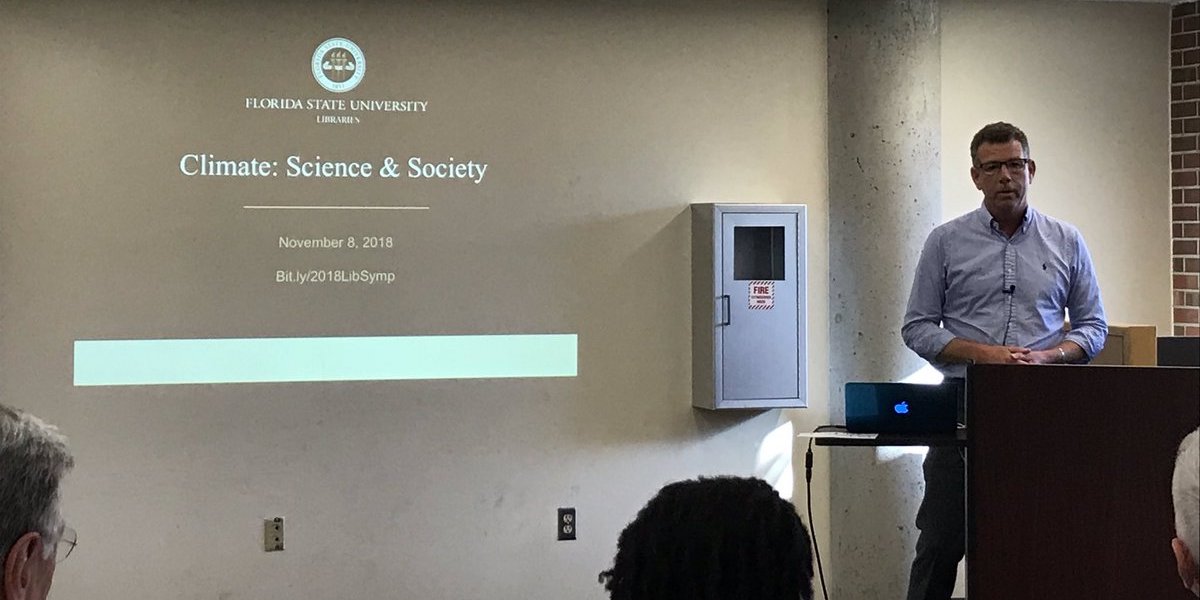The Florida Climate Center serves as the primary resource for climate data, information, and services in the state of Florida.
What's new in our world?
The Florida Climate Center achieves its mission by providing climate monitoring, research, and expertise to be applied by the people, institutions, and businesses of Florida and the surrounding region.
We provide direct service by fulfilling requests for climate and weather data and information in a variety of formats.
We perform research that advances the understanding of the climate variability and changes of Florida and the surrounding region.
We provide outreach in presentations and at events aimed at a variety of groups, interests, and ages.
Prepared by Florida Climate Center
The Florida State University
Tallahassee, FL
Summary:
- Average monthly temperatures in January were near normal for the month.
- Monthly precipitation totals in January were generally above normal, but below normal in parts of central and southeastern Florida.
- With the recent wet and stormy weather so far this season, drought continued to improve in Florida; an area of moderate drought remains along the west-central coast.
- El Niño is expected to persist for the next several months, with a 73% chance of transitioning to ENSO-neutral conditions during April-June 2024. Chances of a historically strong event are just over 50% this winter.
Average monthly temperatures in January were near normal. Average temperature departures from normal ranged from -1.9 ̊F in Pensacola to +2.2 ̊F in Miami for the month (see Table 1 and Appendix 1 for select cities). A hard freeze affected the state in the middle of the month, with minimum temperatures below freezing for three consecutive nights across North Florida and the Panhandle. Crestview reached a low of 18 ̊F on the 17th, which was 20 ̊F below normal but did not set a new record minimum temperature. Temperatures rebounded, however, with well above normal temperatures toward the end of the month. The coolest part of the state for the month was the western Panhandle, while the warmest are of the state was southeastern Florida. Select daily high maximum temperature records tied or broken during the month are provided in Appendix 2.
Table 1. January average temperatures and departures from normal ( ̊F) for selected cities.
| Station | Mean Temperature | Departure from Normal |
| Pensacola | 51.3 | -1.9 |
| Tallahassee | 53.1 | +0.9 |
| Jacksonville | 54.8 | +0.6 |
| Orlando | 62.2 | +1.6 |
| Tampa | 61.7 | -0.3 |
| Miami | 70.8 | +2.2 |
| Key West | 71.4 | +0.8 |
Monthly rainfall totals in January were generally above normal, but below normal in parts of central and southeast Florida. The monthly precipitation departures from normal ranged from -0.94 inches in Miami to +2.43 inches in Fort Myers (see Table 2 and Appendix 1 for select locations). Rain fell in areas that needed it. Heavy rain in south Florida led to drought improvement along west-central coastal areas that have been affected by long-term drought. Naples had its 6th-wettest January on record with a total of 2.21 inches of rain for the month. Fort Myers had its 7th-wettest January on record with monthly precipitation totaling 4.86 inches. Drought was removed in the Panhandle, which had between 5 and 7 inches of rain for the month.
Table 2. January precipitation totals and departures from normal (inches) for selected cities.
| Station | Total Rainfall | Departure from Normal |
| Pensacola | 6.29 | +1.26 |
| Tallahassee | 5.35 | +0.94 |
| Jacksonville | 4.02 | +0.74 |
| Orlando | 1.59 | -0.89 |
| Tampa | 3.12 | +0.47 |
| Miami | 0.89 | -0.94 |
| Key West | 1.83 | 0.00 |
Figure 1. A graphical depiction of the monthly rainfall departure from normal (inches) for January (courtesy of NOAA, NWS).
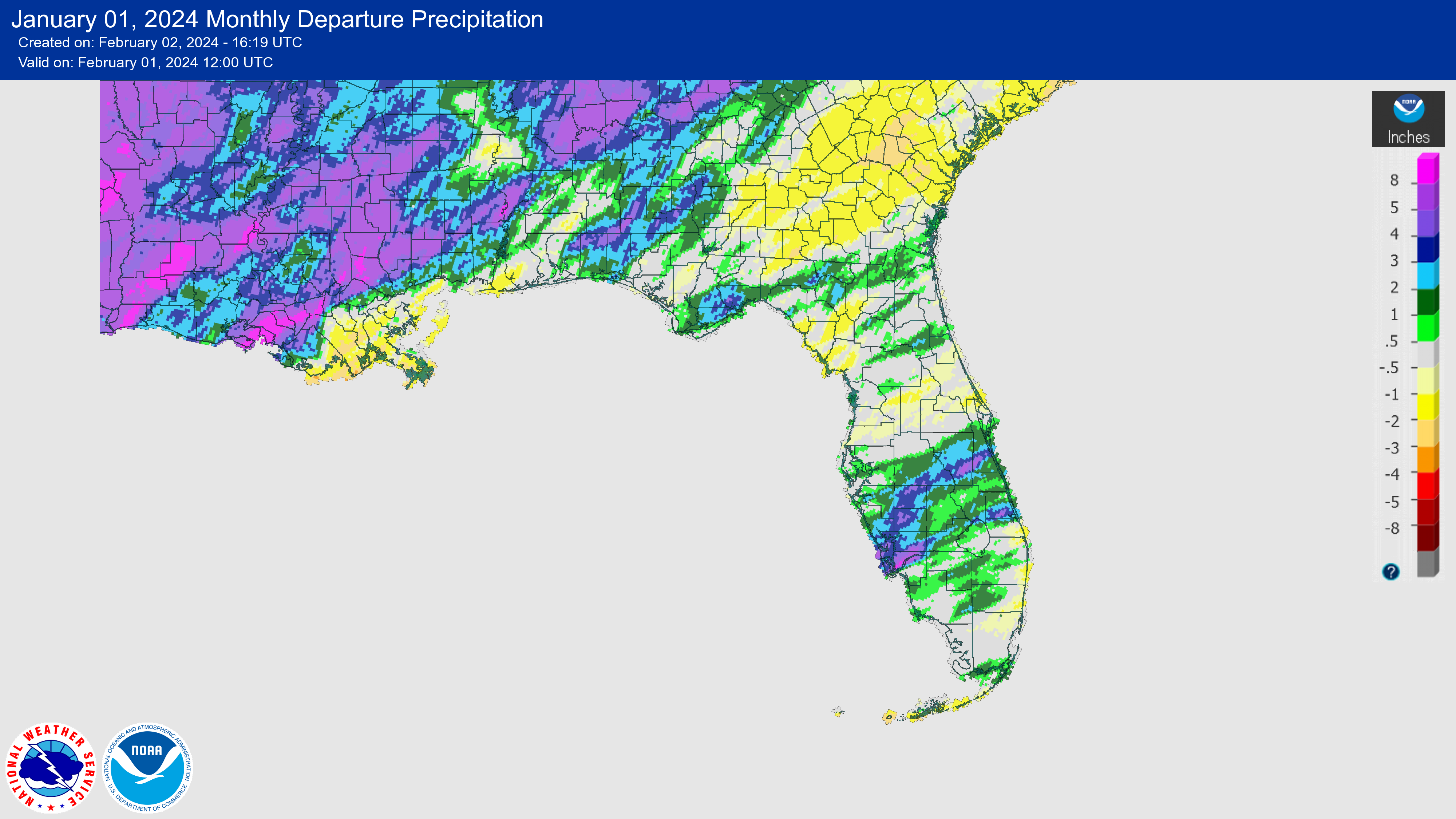
El Niño Advisory.
El Niño conditions, the warm phase of the El Niño Southern Oscillation climate pattern in the tropical equatorial Pacific Ocean, are expected to continue for the next several months. ENSO-neutral conditions are favored during April-June 2024 (now up to a 73% chance). Above-average sea surface temperature anomalies across the equatorial Pacific Ocean have been indicative of a strong El Niño. The largest anomalies have been observed in the central and east-central Pacific, with the latest weekly values at +1.4°C in Niño-4, +1.9°C in Niño-3.4, and +2.0° C in Niño-3 regions. There remains a just over 50% chance of reaching “historically strong” levels this winter.
Hazardous Weather Events in January.
According to the Local Storm Reports issued by the local National Weather Service offices serving Florida, there were 311 individual local reports of hazardous weather events recorded across the state during the month of January (see Table 4 for a breakdown by event type). A severe weather outbreak occurred across the Panhandle and central Florida on January 9th. The storm system moved across the state and led to an outbreak of approximately 14 tornadoes reported in southern GA, AL and in FL, along with damaging straight-line winds. The most powerful tornado, an EF3, was confirmed in Bay County in Lower Grand Lagoon which then moved into Panama City, leaving severe damage along its path. Several EF2 and EF1 tornadoes were reported elsewhere in the Panhandle. An EF1 was reported in northern Hillsborough County and an EF0 in Pinellas County associated with a squall line. In all, there were 9 injuries and 1 fatality associated with the storms.
Table 3. Breakdown of storm reports submitted in Florida during the month of January (compiled from Iowa State University/Iowa Environmental Mesonet).
| Report Type | Number of Reports |
| Heavy Rain | 1 |
| Flood | 2 |
| Flash Flood | 2 |
| Coastal Flood | 6 |
| Hail | 7 |
| Non-Thunderstorm Wind Gust | 34 |
| Non-Thunderstorm Wind Damage | 13 |
| Tornado/Waterspout/Funnel Cloud | 26/3/3 |
| Thunderstorm Wind Damage | 144 |
| Thunderstorm Wind Gust | 68 |
| Lightning | 1 |
| Rip Currents | 1 |
Daily Record Events in January.
Table 4. Summary of daily records broken or set in Florida in January (source: NCEI Daily Weather Records).
| Category | Number of Records |
| Highest daily max. temp. | 30 |
| Highest daily min. temp. | 58 |
| Lowest daily max. temp. | 1 |
| Lowest daily min. temp. | 1 |
| Highest daily precipitation | 31 |
| Total | 121 |
Drought-Related Impacts.
Stormy, wet conditions in Florida have led to improved drought conditions across west-central Florida and the western Panhandle. By mid-January, approximately 1.4% of the state was in moderate drought (D1) and 2.7% was abnormally dry (D0), according to the U.S. Drought Monitor. By the end of the month, slight improvement had occurred with 1.3% of the state in moderate drought (D1) and 1.4% abnormally dry (D0) (see Figure 2 below). Drought removal is likely during February-April.
As of January 31, the Lake Okeechobee water level was 16.29 ft. above sea level (Feet-NGVD29), which is above average for this time of year. At the first of the month, the water level was 15.98 ft. above sea level.
Figure 2. A graphical depiction of the latest drought conditions in Florida according to the U.S. Drought Monitor (courtesy of the National Drought Mitigation Center, University of Nebraska-Lincoln).
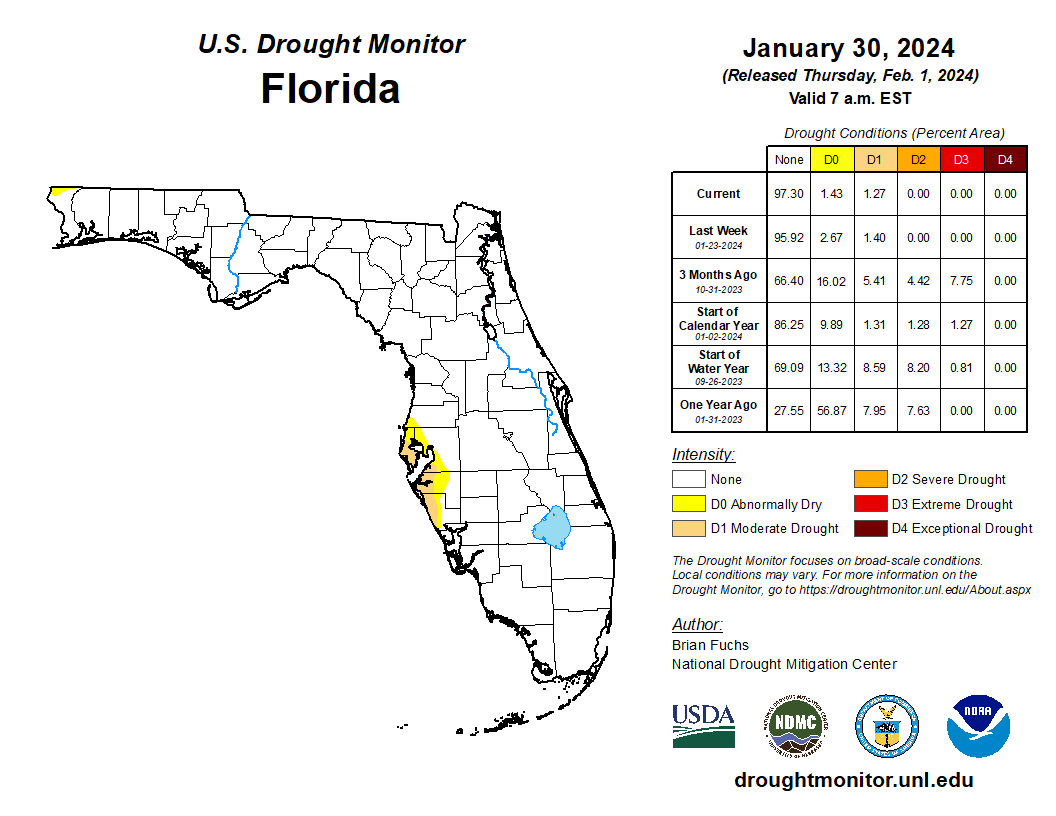
Agriculture-Related Impacts.
In January, a hard freeze was experienced during the middle of the month in many northern counties but no significant impacts to crops were reported. Drought improved due to moderate to heavy rainfall observed across much of the state during the month. Soil moisture increased as a result. Pasture conditions were mostly fair to good, though some pastures were overly saturated due to the frequent and heavy rainfall. Livestock was also mostly fair to good but supplemental hay was used when pastures were too wet or growth was limited due to cold temperatures. Some sugarcane operations were delayed due to high winds and heavy rain. Damages to citrus crops due to the hard freeze mid-month are still being assessed but were likely confined to new plantings. Among the crops that were planted and harvested in January included sugarcane, tomatoes, green beans, avocado, and tropical fruits. For more information, consult the Crop Progress State Stories, which is published by the USDA’s National Agricultural Statistics Service December through March.
Appendix 1
Additional January departures from normal data for select Florida locations (Source: NWS).
| Station | Average Temperature (˚F) | Departure from Normal (˚F) | Total Rainfall (in.) | Departure from Normal (in.) |
| Gainesville | 56.6 | +1.8 | 3.44 | +0.15 |
| Sarasota | 63.0 | +0.6 | 4.31 | +1.52 |
| Naples | 66.3 | +1.0 | 2.21 | +0.53 |
| Fort Myers | 65.5 | +0.8 | 4.86 | +2.43 |
| West Palm Beach | 68.3 | +2.0 | 2.62 | -0.85 |
Appendix 2
Select daily record high maximum temperatures (°F) broken or tied during January (compiled from NOAA).
| Location | Date | Record | Broken/Tied | Last |
| Lakeland | 9 | 91 | Broken | 87 in 2013 |
| Miami | 12 | 87 | Broken | 84 in 2018 |
| West Palm Beach | 12 | 87 | Broken | 83 in 2020 |
| Fort Lauderdale | 13 | 86 | Broken | 83 in 2020 |
| Homestead | 13 | 86 | Broken | 83 in 2020 |
| Perrine | 13 | 85 | Broken | 83 in 1994 |
| Miami | 13 | 86 | Broken | 84 in 1993 |
| Key West | 15 | 84 | Tied | 84 in 2020 |
| Hialeah | 16 | 85 | Tied | 85 in 1997 |
| Homestead | 16 | 84 | Broken | 83 in 1991 |
| West Palm Beach | 16 | 85 | Broken | 84 in 1954 |
| Fort Lauderdale | 17 | 84 | Broken | 82 in 2020 |
| Perrine | 17 | 84 | Broken | 83 in 1991 |
| Tallahassee | 24 | 80 | Broken | 78 in 1974 |
| Tampa | 25 | 86 | Broken | 84 in 2012 |
| Gainesville | 25 | 83 | Broken | 82 in 2023 |
| Clermont | 27 | 86 | Broken | 85 in 1950 |
| Hastings | 27 | 82 | Broken | 81 in 2017 |
| Plant City | 27 | 88 | Broken | 86 in 1962 |
| Tampa | 27 | 85 | Broken | 82 in 2009 |
| Orlando | 27 | 85 | Broken | 84 in 1962 |
| Gainesville | 27 | 84 | Broken | 82 in 1962 |
| Lakeland | 27 | 85 | Broken | 84 in 1962 |
| Clermont | 28 | 87 | Broken | 84 in 2021 |
| Hialeah | 28 | 86 | Broken | 85 in 1963 |
| Fort Lauderdale | 29 | 85 | Broken | 82 in 2012 |
Prepared by Florida Climate Center
The Florida State University
Tallahassee, FL
Summary:
- Average monthly temperatures in February were near to below normal.
- Monthly precipitation totals were below normal in North Florida and above normal in South Florida.
- With the wet and stormy weather this season, drought has virtually disappeared in Florida.
- El Niño is beginning to weaken and is expected to transition to ENSO-neutral conditions during April-June 2024 (79% chance), with a possible transition to La Niña during June-August (55% chance).
Average monthly temperatures in February were near to below normal. Average temperature departures from normal ranged from -2.2 ̊F in Key West to +0.9 ̊F in Tallahassee for the month (see Table 1 and Appendix 1 for select cities). Temperatures vacillated throughout the month between below and above normal, averaging out to near normal for the month as a whole. South Florida was the coolest part of the state, with monthly average temperatures ranging from 1-4 ̊F below normal, while the Panhandle was about 1 ̊F above normal for the month. Very few daily high or low temperature records were broken during the month.
Table 1. February average temperatures and departures from normal ( ̊F) for selected cities.
| Station | Mean Temperature | Departure from Normal |
| Pensacola | 57.5 | +0.7 |
| Tallahassee | 56.5 | +0.9 |
| Jacksonville | 57.5 | 0.0 |
| Orlando | 63.6 | 0.0 |
| Tampa | 63.3 | -1.4 |
| Miami | 69.0 | -1.7 |
| Key West | 70.1 | -2.2 |
Monthly rainfall totals in February were below normal in North Florida and above normal in South Florida. The monthly precipitation departures from normal ranged from -3.40 inches in Pensacola to +2.71 inches in Key West (see Table 2 and Appendix 1 for select locations). South Florida remained wet during February, while rainfall in North Florida and the Panhandle ended up below normal for the month. Naples, Melbourne, and Key West had their 2nd-wettest February on record, while Pensacola had its 3rd-driest February on record. Winter precipitation (DJF) was above normal across Florida overall, with some areas receiving 6+ inches of surplus rainfall in the Florida Panhandle. It was the wettest winter on record for Apalachicola and Key West, and it was the 2nd-wettest winter on record in Tallahassee, Venice, Fort Myers, and Melbourne. El Nino rainfall since December led to drought removal across the state by the end of February.
Table 2. February precipitation totals and departures from normal (inches) for selected cities.
| Station | Total Rainfall | Departure from Normal |
| Pensacola | 1.37 | -3.40 |
| Tallahassee | 2.25 | -2.03 |
| Jacksonville | 2.44 | -0.42 |
| Orlando | 2.41 | +0.37 |
| Tampa | 3.32 | +0.70 |
| Miami | 3.03 | +0.88 |
| Key West | 4.25 | +2.71 |
Figure 1. A graphical depiction of the monthly rainfall departure from normal (inches) for February (courtesy of NOAA, NWS).
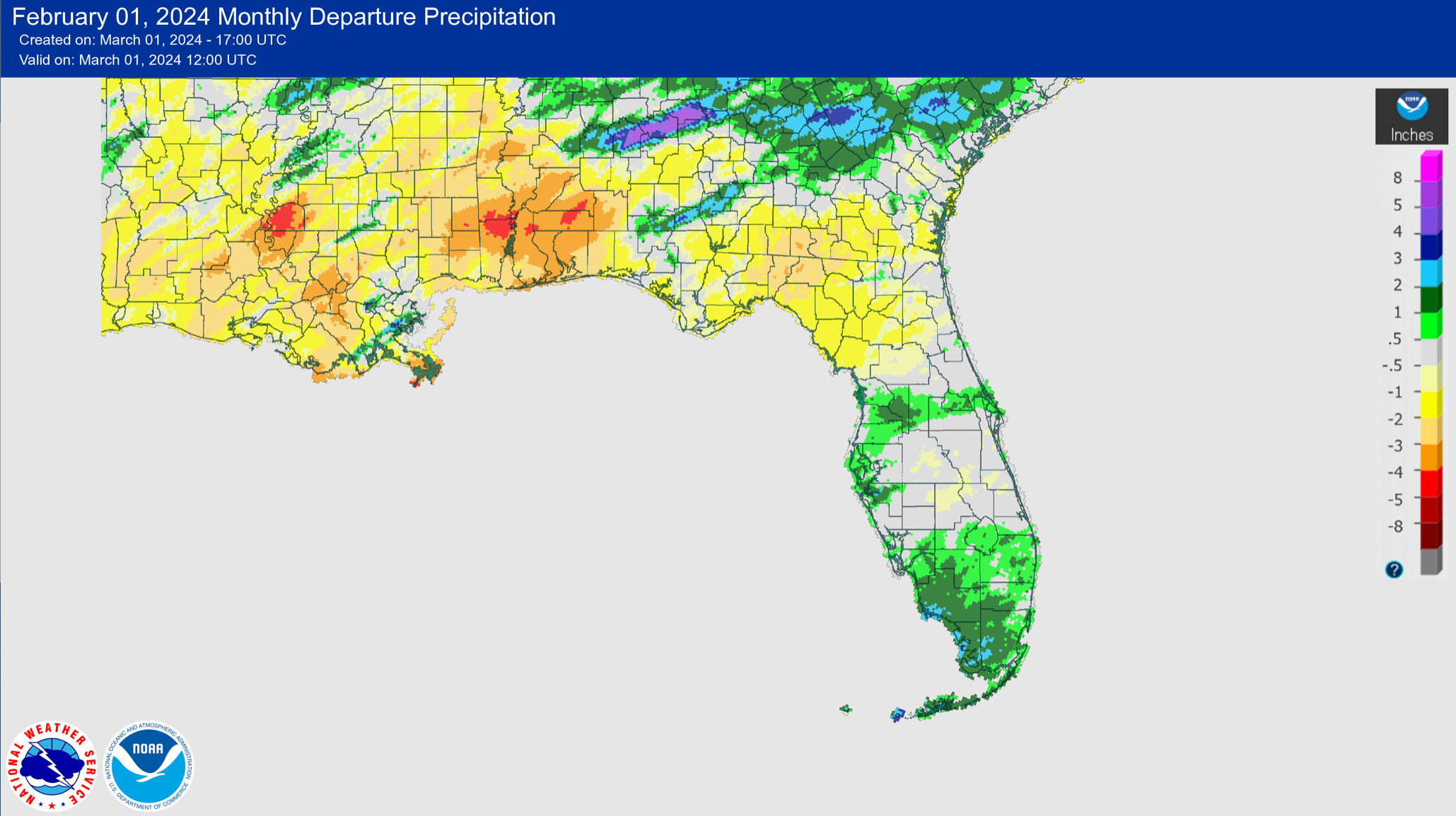
El Niño Advisory.
El Niño conditions, the warm phase of the El Niño Southern Oscillation climate pattern in the tropical equatorial Pacific Ocean, continued but SST anomalies and area-averaged subsurface temperature anomalies have weakened in the eastern and east-central Pacific. Atmospheric anomalies across the topical Pacific Ocean also weakened. A transition to ENSO-neutral conditions is expected during April-June 2024 (79% chance). There are increasing chances of a transition to La Niña during June-August (55% chance). Despite the spring predictability barrier, historical data indicate that La Niña tends to follow strong El Niño events, providing greater reliability in the forecast.
Hazardous Weather Events in February.
According to the Local Storm Reports issued by the local National Weather Service offices serving Florida, there were 206 individual local reports of hazardous weather events recorded across the state during the month of February (see Table 4 for a breakdown by event type). Stormy weather was reported throughout the month, with strong winds and up to 1.5-inch sized hail. Several tornadoes were reported, with some damage associated with these storms but no injuries or fatalities.
Table 3. Breakdown of storm reports submitted in Florida during the month of February (compiled from Iowa State University/Iowa Environmental Mesonet).
| Report Type | Number of Reports |
| Heavy Rain | 8 |
| Flood | 0 |
| Flash Flood | 0 |
| Coastal Flood | 1 |
| Hail | 40 |
| Non-Thunderstorm Wind Gust | 93 |
| Non-Thunderstorm Wind Damage | 0 |
| Tornado/Waterspout/Funnel Cloud | 8/0/0 |
| Thunderstorm Wind Damage | 9 |
| Thunderstorm Wind Gust | 46 |
| Rip Currents | 1 |
| Wildfire | 1 |
Daily Record Events in February.
Table 4. Summary of daily records broken or set in Florida in February (source: NCEI Daily Weather Records).
| Category | Number of Records |
| Highest daily max. temp. | 1 |
| Highest daily min. temp. | 4 |
| Lowest daily max. temp. | 1 |
| Lowest daily min. temp. | 0 |
| Highest daily precipitation | 25 |
| Total | 31 |
Weather/Climate Highlights of the Month: El Niño.
This El Niño event will rank as the 5th-strongest El Niño on record since 1950, with a SST Niño-3.4 index value over +2.0 ºC. This has been a very typical and impactful El Niño event, with a very cloudy, rainy and stormy winter across Florida. Severe weather reports since January 1 show a cluster of tornado and severe wind reports in the Panhandle and southeast Florida.
El Niño started a bit late, and we had a streak of around 30 consecutive days without measurable rainfall in north Florida during October-November, which resulted in the development of flash drought in the western Panhandle in November. However, by December, El Niño rainfall began to kick in and during December-February, some places had as many as 30 days with measurable rainfall. Stream flows are now running normal to above normal across the state. It became the cloudiest winter on record in the Florida Peninsula, based on an 84-year period.
All strong El Niño events in the past were followed by a rapid transition to La Niña conditions the following summer. It is looking likely that this will happen again this year. Given recent forecasts, we are now in both an El Niño Advisory and a La Niña watch at the same time.
Drought-Related Impacts.
Above-normal rainfall this winter has led to drought removal in Florida. By mid-February, approximately 1.27% of the state remained in moderate drought (D1) and 1.28% was abnormally dry (D0), according to the U.S. Drought Monitor. By the end of the month, moderate drought (D1) had been removed and 3.28% was abnormally dry (D0) (see Figure 3 below).
As of February 29, the Lake Okeechobee water level was 16.15 ft. above sea level (Feet-NGVD29), which is above average for this time of year. At the first of the month, the water level was 16.28 ft. above sea level.
Figure 2. A graphical depiction of the latest drought conditions in Florida according to the U.S. Drought Monitor (courtesy of the National Drought Mitigation Center, University of Nebraska-Lincoln).

Agriculture-Related Impacts.
In February, moderate amounts of rainfall and near normal temperatures have led to mostly fair to good pasture and livestock conditions during the month. Some sugarcane operations were delayed due to high winds and heavy rain. Blueberries have been starting to bloom; however, strawberry producers in central Florida experienced significant fruit damage and drop from rain and wind mid-month. Heavy rains also delayed rice planting. First spring leaf out was delayed in northern Florida this season due to cold conditions earlier in winter. For more information, consult the Crop Progress State Stories, which is published by the USDA’s National Agricultural Statistics Service December through March.
Appendix 1
Additional February departures from normal data for select Florida locations (Source: NWS).
| Station | Average Temperature (˚F) | Departure from Normal (˚F) | Total Rainfall (in.) | Departure from Normal (in.) |
| Gainesville | 58.4 | 0.0 | 2.45 | -0.22 |
| Sarasota | 63.4 | -1.4 | 3.26 | -1.34 |
| Naples | 64.9 | -0.3 | 2.90 | +0.84 |
| Fort Myers | 65.6 | -1.7 | 2.61 | +0.83 |
| West Palm Beach | 67.5 | -0.9 | 3.05 | +0.42 |
Prepared by Florida Climate Center
The Florida State University
Tallahassee, FL
Summary:
- Average monthly temperatures in October were near to above normal.
- Following heavy rainfall from Hurricane Milton, the rest of October was mostly dry; monthly precipitation totals were above normal in areas impacted by Milton and below normal across the Panhandle and North Florida.
- Drying conditions across the Panhandle led to the development of abnormally dry conditions (D0) toward the end of the month.
- A transition to La Niña conditions is favored during September-November, albeit with a lower probability (60% chance); it is expected to be a weak La Niña event.
- Hurricane Milton made landfall near Siesta Key in Sarasota County on October 9 as a category 3 hurricane with peak winds of 120 mph, following on the heels of Hurricane Helene.
Average monthly temperatures in October were near to above normal in Florida. Average monthly temperature departures from normal ranged from -0.4 ̊F in Sarasota to +2.0 ̊F in Daytona Beach for the month (see Table 1 and Appendix 1 for select cities). October saw temperature swings across the state associated with upper air patterns. The month began with above normal temperatures, but a cold front impacted northern Florida and the Panhandle mid-month, bringing minimum temperatures down 8-14 degrees below normal. Minimum temperatures reached as low as 39 ̊F in Tallahassee and Chipley, and 35 ̊F in Crestview. Temperatures rebounded during the second half of the month with much warmer than normal mean temperatures across the state as a ridge of high pressure set up over the Southeast US region. Maximum temperatures were near record warm across North Florida in late October. No monthly temperature records were set but some daily temperature records were set during the month (see Appendix 2).
Table 1. October average temperatures and departures from normal ( ̊F) for selected cities.
| Station | Mean Temperature | Departure from Normal |
| Pensacola | 72.5 | +1.2 |
| Tallahassee | 71.7 | +1.4 |
| Jacksonville | 72.2 | +1.0 |
| Orlando | 76.8 | +1.3 |
| Tampa | 77.2 | -0.2 |
| Miami | 80.2 | +0.1 |
| Key West | 81.8 | +0.5 |
Monthly precipitation totals were above normal in areas impacted by Hurricane Milton and below normal across the Panhandle and North Florida. The monthly precipitation departures from normal ranged from -3.41 inches in Pensacola to +11.94 inches in Tampa (see Table 2 and Appendix 1 for select locations). The fingerprint of Hurricane Milton is clear in the October monthly rainfall departure from normal map (Figure 1), with several inches below normal rainfall in the Panhandle (orange) to greater than 8 inches across central Florida (violet). Several stations in central Florida recorded their wettest Octobers on record, including Tampa (135 years), Sarasota (113 years), Lakeland (61 years), and Sanford (76 years). This area saw surplus rainfall ranging from 9 to over 15 inches of rainfall for the month. While October is typically a dry month, the Florida Panhandle fell several inches below normal in October. Between October 4 and November 4, Panhandle communities had between 26 and 31 consecutive days with no measurable rainfall. Warmer than normal temperatures and dry weather have led to abnormally dry conditions across the western Panhandle (Figure 2).
Table 2. October precipitation totals and departures from normal (inches) for selected cities.
| Station | Total Rainfall | Departure from Normal |
| Pensacola | 1.29 | -3.41 |
| Tallahassee | 0.22 | -3.02 |
| Jacksonville | 1.85 | -2.18 |
| Orlando | 5.13 | +1.67 |
| Tampa | 14.28 | +11.94 |
| Miami | 7.50 | -0.15 |
| Key West | 3.31 | -2.36 |
Figure 1. A graphical depiction of the monthly rainfall departure from normal (inches) for October (courtesy of NOAA, NWS).
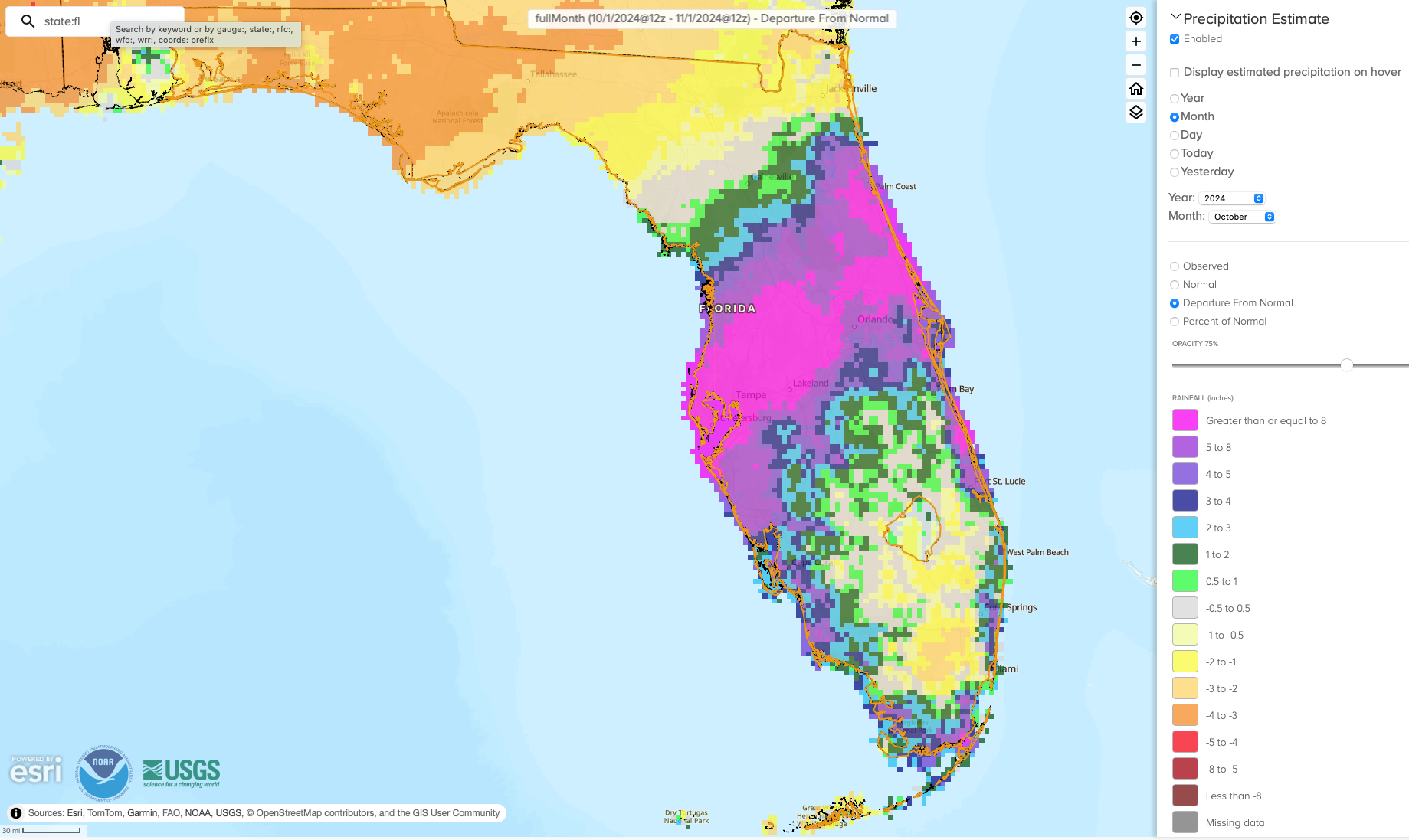
La Niña Watch.
ENSO-neutral conditions have continued in the tropical equatorial Pacific Ocean over the past month with near-average sea surface temperatures in the central and eastern equatorial Pacific Ocean. La Niña conditions are expected to emerge during September-November 2024 (60% chance) and persist through January-March 2025. The probability of La Niña is lower compared to last month, and forecasters expect a weak La Niña event. The expected weak La Niña pattern has increased the odds of below-normal precipitation for November thru February across Florida, according to the Climate Prediction Center’s seasonal outlook.
Hazardous Weather Events in October.
According to the Local Storm Reports issued by the local National Weather Service offices serving Florida, there were 458 individual local reports of hazardous weather events recorded across the state during the month of October (see Table 4 for a breakdown by event type). The majority of reports during the month were related to Hurricane Milton, which made landfall near Siesta Key, FL on the night of October 9 as a category 3 hurricane. The storm produced flash flooding, high storm surge, and a record number of tornadoes on October 9. There was a total of 126 tornado warnings issued by NWS offices serving Florida on October 9. High storm rainfall totals over 10 inches and high hourly rainfall rates led to flash flooding and riverine flooding particularly in areas to the north of the storm’s center. Storm surge along the western Gulf coast added to damages from storm surge and coastal erosion experienced less than two weeks prior during Hurricane Helene. More on the storm is provided below.
Table 3. Breakdown of storm reports submitted in Florida during the month of October (compiled from Iowa State University/Iowa Environmental Mesonet).
| Report Type | Number of Reports |
| Heavy Rain | 97 |
| Flood | 17 |
| Flash Flood | 7 |
| Coastal Flood | 2 |
| Marine Thunderstorm Wind | 4 |
| Non-Thunderstorm Wind Gust | 43 |
| Non-Thunderstorm Wind Damage | 0 |
| Tornado/Waterspout/Funnel Cloud | 60/6/0 |
| Thunderstorm Wind Damage | 1 |
| Thunderstorm Wind Gust | 67 |
| Tropical Cylone | 144 |
| Storm Surge | 8 |
| Rip Currents | 2 |
Daily Record Events in October.
Table 4. Summary of daily records broken or set in Florida in October (source: NCEI Daily Weather Records).
| Category | Number of Records |
| Highest daily max. temp. | 32 |
| Highest daily min. temp. | 21 |
| Lowest daily max. temp. | 12 |
| Lowest daily min. temp. | 4 |
| Highest daily precipitation | 25 |
| Total | 94 |
Weather/Climate Highlights of the Month: Hurricane Milton
Hurricane Milton made landfall as a major category 3 hurricane near Siesta Key, FL in Sarasota County on the night of October 9 with sustained winds of 120 mph. Milton made landfall less than 2 weeks following Hurricane Helene, which hit the Florida Big Bend region on September 26 as a category 4 hurricane. The back-to-back storms caused compounding impacts to communities along Florida’s west coast. Milton produced damaging storm surge flooding, as well as hurricane-force winds, heavy rainfall, and a record number of tornadoes across Florida’s Peninsula. Read more about Milton and its impacts in Florida in our post-storm summary report.
Hurricane Milton on October 8, 2024, at 6:30 pm Eastern Time as captured by NOAA’s GOES-16 satellite. (Credit: NOAA)

Drought-Related Impacts.
In mid-October, about 1% of the state was experiencing abnormally dry (D0) conditions, according to the U.S. Drought Monitor. By the end of the month, moderate drought (D1) affected 1.4% of the state and about 20% of the state was abnormally dry (D0) (Figure 2 below).
As of October 31, the Lake Okeechobee water level was 16.10 ft. above sea level (Feet-NGVD29), which is above average for this time of year. At the first of the month, the water level was 15.35 ft. above sea level.
Figure 2. A graphical depiction of the latest drought conditions in Florida according to the U.S. Drought Monitor (courtesy of the National Drought Mitigation Center, University of Nebraska-Lincoln).
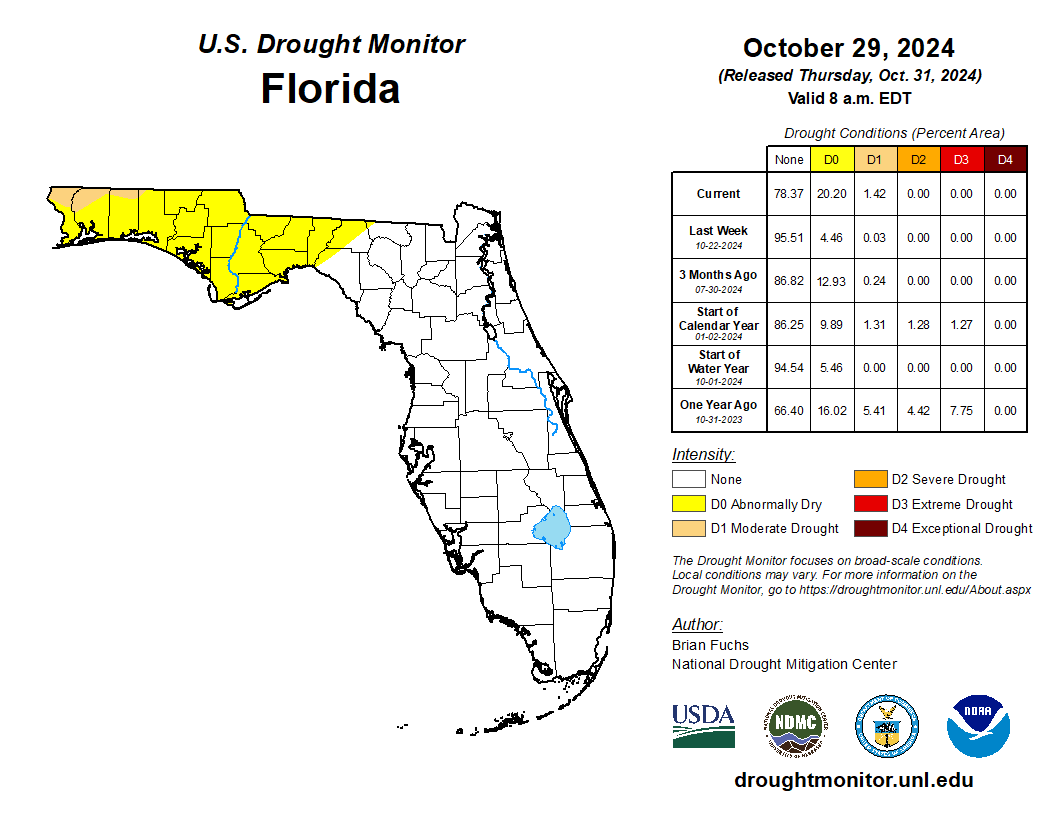
Agriculture-Related Impacts.
Despite back-to-back hurricanes impacting the state, little rainfall since has led to quickly deteriorating conditions in the Florida Panhandle. In mid-October, topsoil moisture conditions were adequate in 72% of the state, short in 9%, and very short in 1% of the state, while 18% of the state had surplus topsoil moisture conditions. By the end of October, topsoil moisture conditions were adequate in 62% of the state, short in 21%, and very short in 7% of the state, while 10% had surplus topsoil moisture conditions. For more information, consult the Crop Progress and Conditions report, which is published by the USDA’s National Agricultural Statistics Service.
Appendix 1
Additional October departures from normal data for select Florida locations (Source: NWS).
| Station | Average Temperature (˚F) | Departure from Normal (˚F) | Total Rainfall (in.) | Departure from Normal (in.) |
| Gainesville | 71.8 | +0.4 | 4.79 | +2.11 |
| Sarasota | 76.9 | -0.4 | 12.59 | +9.83 |
| Daytona Beach | 76.4 | +2.0 | 13.37 | +8.52 |
| Naples | 80.1 | +1.6 | 4.39 | +0.46 |
| Fort Myers | 78.7 | +0.7 | 7.16 | +4.08 |
| West Palm Beach | 79.5 | +0.8 | 9.88 | +3.98 |
Appendix 2
Select daily record high maximum temperatures (°F) tied or broken during October 2024 (compiled from NOAA).
| Location | Date | Record | Broken/Tied | Last |
| Clermont | 1 | 96 | Broken | 94 in 2019 |
| Fort Lauderdale | 1 | 93 | Broken | 92 in 2015 |
| Plant City | 1 | 101 | Broken | 98 in 1904 |
| Kissimmee | 1 | 94 | Tied | 94 in 1977 |
| Vero Beach | 1 | 92 | Broken | 91 in 1989 |
| Ochopee | 2 | 96 | Broken | 95 in 2002 |
| Naples | 2 | 93 | Tied | 93 in 2023 |
| Fort Myers | 2 | 94 | Tied | 94 in 1988 |
| Tampa | 3 | 94 | Tied | 94 in 1990 |
| Tampa | 4 | 93 | Broken | 92 in 2023 |
| Gainesville | 4 | 91 | Tied | 91 in 2019 |
| Key West | 4 | 92 | Broken | 91 in 2021 |
| Pensacola | 8 | 90 | Broken | 89 in 2019 |
| Fernandina Beach | 15 | 91 | Broken | 89 in 1925 |
| Pensacola | 24 | 87 | Broken | 86 in 1978 |
| Marianna | 25 | 90 | Broken | 89 in 2010 |
| Tallahassee | 25 | 91 | Broken | 88 in 1984 |
| Chipley | 26 | 90 | Tied | 90 in 1939 |
| Fernandina Beach | 26 | 88 | Broken | 86 in 1963 |
| Crestview | 26 | 88 | Broken | 87 in 2020 |
| Tallahassee | 26 | 91 | Broken | 88 in 1984 |
| Tallahassee | 27 | 90 | Broken | 89 in 1984 |
| Niceville | 28 | 88 | Broken | 85 in 1984 |
| Fernandina Beach | 30 | 89 | Broken | 87 in 1922 |
Prepared by Florida Climate Center
The Florida State University
Tallahassee, FL
Summary:
- Average monthly temperatures in April were near normal in Florida.
- Monthly precipitation totals in April were generally below normal except in the eastern Panhandle and north Florida where precipitation was above normal for the month.
- Drier conditions throughout the month of April led to drought development in the south-central region of the Peninsula from Brevard County south to northern Palm Beach County.
- A transition to ENSO-neutral conditions is expected April-June 2024 (85% chance); a transition to La Niña is likely during June-August (60% chance).
Average monthly temperatures in April were near normal around the state. Average monthly temperature departures from normal ranged from +0.9 ̊F in Tallahassee to -0.6 ̊F in Gainesville for the month (see Table 1 and Appendix 1 for select cities). Both Tallahassee and Jacksonville saw their first 90 ̊F day of the year on April 19th. This is about 10 days earlier in Tallahassee compared to the long-term average date of April 29 and 6 days earlier in Jacksonville where the long-term average date is April 25. There were a few daily maximum and minimum temperature records were set during the month.
Table 1. April average temperatures and departures from normal ( ̊F) for selected cities.
| Station | Mean Temperature | Departure from Normal |
| Pensacola | 68.5 | +0.2 |
| Tallahassee | 68.2 | +0.9 |
| Jacksonville | 68.7 | +0.6 |
| Orlando | 72.6 | +0.4 |
| Tampa | 73.7 | -0.2 |
| Miami | 76.3 | -0.4 |
| Key West | 77.8 | -0.1 |
Monthly rainfall totals in April were below normal except in the eastern Panhandle, northern Florida, and in other isolated areas. The monthly precipitation departures from normal ranged from -1.25 inches in Orlando to +6.94 inches in Ocala (see Table 2 and Appendix 1 for select locations). Tallahassee collected a total of 7.41 inches of rain for the month, which ranks as the 11th-wettest April on record. Most of the monthly rainfall in Tallahassee fell in just a few hours overnight on April 10-11 associated with a severe storm; the remainder of the month was mostly dry. Tallahassee recorded a new daily precipitation record on the 11th with 4.89 inches; the previous record on this day was 1.79 inches in 1975. Quincy and Perry also recorded new daily precipitation records on the 11th with 4.00 inches and 2.85 inches, respectively. Ocala collected 9.16 inches of rain in April, which was 6.94 inches above normal and ranks as the 3rd-wettest April on record based on a 118-year period of record. Ocala also had a new daily precipitation record on April 11 with 7.45 inches, smashing the previous record of 3.51 inches in 1975. Elsewhere in the state, conditions were generally drier than normal and drought emerged in the Okeechobee region in the south-central Peninsula (see below for more drought information).
Table 2. April precipitation totals and departures from normal (inches) for selected cities.
| Station | Total Rainfall | Departure from Normal |
| Pensacola | 4.38 | -1.14 |
| Tallahassee | 7.41 | +3.88 |
| Jacksonville | 2.05 | -0.88 |
| Orlando | 1.33 | -1.25 |
| Tampa | 1.34 | -1.21 |
| Miami | 2.78 | -0.58 |
| Key West | 1.35 | -0.72 |
Figure 1. A graphical depiction of the monthly rainfall departure from normal (inches) for April (courtesy of NOAA, NWS).

El Niño Advisory / La Niña Watch.
El Niño conditions, the warm phase of the El Niño Southern Oscillation climate pattern in the tropical equatorial Pacific Ocean, have continued to weaken and a transition to ENSO-neutral conditions is likely on the horizon. The transition to ENSO-neutral conditions is expected by April-June 2024 (85% chance). There are increasing chances of a La Niña developing during June-August 2024 (60% chance), which increases to an 80% chance during August-October 2024.
Hazardous Weather Events in April.
According to the Local Storm Reports issued by the local National Weather Service offices serving Florida, there were 286 individual local reports of hazardous weather events recorded across the state during the month of April (see Table 4 for a breakdown by event type). A strong storm on April 10-11 impacted Leon and surrounding counties, generating widespread flash flooding. Reports of washed-out roadways and flooded buildings were reported in Leon, Jefferson, and Gadsden Counties. Rainfall amounts of 6 – 8 inches were reported by WeatherSTEM gauges and at the Tallahassee International Airport, which mostly fell within a 12-hour period. Several CoCoRaHS stations in eastern Leon County and Jefferson County reported over 9.0 inches of rain from the storm. A tornado on the 13th in St. Johns County caused a minor injury, and wildfires were reported in the Ocala National Forest in Lake County, in Collier County, and Miami-Dade County.
Table 3. Breakdown of storm reports submitted in Florida during the month of April (compiled from Iowa State University/Iowa Environmental Mesonet).
| Report Type | Number of Reports |
| Heavy Rain | 5 |
| Flood | 6 |
| Flash Flood | 67 |
| Coastal Flood | 0 |
| Hail | 1 |
| Marine Thunderstorm Wind | 25 |
| Non-Thunderstorm Wind Gust | 44 |
| Non-Thunderstorm Wind Damage | 2 |
| Tornado/Waterspout/Funnel Cloud | 5/4/2 |
| Thunderstorm Wind Damage | 62 |
| Thunderstorm Wind Gust | 52 |
| Rip Currents | 1 |
| Lightning | 5 |
| Wildfire | 5 |
Daily Record Events in April.
Table 4. Summary of daily records broken or set in Florida in April (source: NCEI Daily Weather Records).
| Category | Number of Records |
| Highest daily max. temp. | 7 |
| Highest daily min. temp. | 10 |
| Lowest daily max. temp. | 4 |
| Lowest daily min. temp. | 5 |
| Highest daily precipitation | 16 |
| Total | 42 |
Drought-Related Impacts.
By mid-April, approximately 13% of the state was experiencing abnormally dry (D0) conditions, concentrated in the Okeechobee region of the Peninsula, according to the U.S. Drought Monitor. By the end of the month, about 9% of the state was in moderate drought (D1) and 18% of the state was abnormally dry (see Figure 3 below).
As of April 30, the Lake Okeechobee water level was 14.19 ft. above sea level (Feet-NGVD29), which is above average for this time of year. At the first of the month, the water level was 15.20 ft. above sea level.
Figure 2. A graphical depiction of the latest drought conditions in Florida according to the U.S. Drought Monitor (courtesy of the National Drought Mitigation Center, University of Nebraska-Lincoln).

Agriculture-Related Impacts.
In mid-April, topsoil moisture conditions were adequate in 75% of the state, short in 16%, and very short in 2% of the state, while 7% of the state had surplus topsoil moisture conditions. Near the end of April, topsoil moisture conditions were adequate in 53% of the state, short in 38%, and very short in 9% of the state; no portion of the state was in surplus. While wetter soils earlier in the season were causing problems for planting, drier and warmer weather that has developed more recently has helped. For more information, consult the Crop Progress and Conditions report, which is published by the USDA’s National Agricultural Statistics Service.
Appendix 1
Additional April departures from normal data for select Florida locations (Source: NWS).
| Station | Average Temperature (˚F) | Departure from Normal (˚F) | Total Rainfall (in.) | Departure from Normal (in.) |
| Gainesville | 67.9 | -0.6 | 3.13 | +0.39 |
| Ocala | 70.3 | -0.4 | 9.16 | +6.94 |
| Sarasota | 72.2 | -0.4 | 1.06 | -1.40 |
| Naples | 75.3 | +0.7 | 0.09 | -2.43 |
| Fort Myers | 74.6 | -0.2 | 0.87 | -1.57 |
| West Palm Beach | 75.4 | +0.5 | 5.57 | +1.89 |
Prepared by Florida Climate Center
The Florida State University
Tallahassee, FL
Summary:
- This month brought extreme weather and record heat to the state.
- Average monthly temperatures in May were above normal, with record warmth across central and southern Florida.
- Monthly precipitation totals were above normal in the Panhandle and below normal in the Peninsula.
- Drought expanded across central to south Florida and severe drought (D2) was introduced in Sarasota and Charlotte Counties east to parts of Highlands and Glades Counties.
- A transition to ENSO-neutral conditions is expected sometime in the next month; a transition to La Nina conditions is expected during July-September (69% chance).
Average monthly temperatures in May were above normal. Average monthly temperature departures from normal ranged from +1.5 ̊F in Pensacola to +5.5 ̊F in West Palm Beach for the month (see Table 1 and Appendix 1 for select cities). It was still technically spring, but May 2024 felt like the middle of summer in southern Florida with record breaking heat indices during the middle and end of the month. May 2024 became the hottest May on record for most stations throughout the Peninsula, including Orlando, Melbourne, Tampa, Sarasota, Lakeland, Fort Myers, Naples, West Palm Beach, Miami, Homestead, and Key West. The Hollywood North Perry Airport hit 100 ̊F on May 15th and 26th, and it hit 101 ̊F on the 19th, which became the all-time highest temperature for that station. The Sarasota Bradenton AP reached a high temperature of 99 ̊F on the 30th. West Palm Beach and Fort Lauderdale experienced a peak heat index of 115 ̊F on May 18th. The Miami International Airport station reached triple digit heat indices earliest on record and tied its 3rd-highest heat index value of 112 ̊F on the 18th and 19th. Key West hit a heat index value of 114 ̊F on the 15th. High SSTs and a large area of high pressure are contributing to these extreme temperatures. There was a total of 146 daily high maximum temperature records set during the month; select daily high maximum temperature records are provided in Appendix 2.
Table 1. May average temperatures and departures from normal ( ̊F) for selected cities.
| Station | Mean Temperature | Departure from Normal |
| Pensacola | 77.5 | +1.5 |
| Tallahassee | 78.6 | +3.4 |
| Jacksonville | 78.3 | +3.4 |
| Orlando | 81.4 | +4.1 |
| Tampa | 83.0 | +3.5 |
| Miami | 83.7 | +3.6 |
| Key West | 84.7 | +3.6 |
Monthly rainfall totals in May were above normal in the Panhandle and below normal across the Peninsula. The monthly precipitation departures from normal ranged from -5.89 inches in Ft. Lauderdale to +4.33 inches in Tallahassee (see Table 2 and Appendix 1 for select locations). Sarasota experienced its driest May on record (based on a 113-year period of record). As a result of drying conditions and record high temperatures across the central and southern Peninsula, moderate drought conditions expanded and severe drought emerged in southwest Florida in parts of Sarasota and Charlotte Counties east to Glades and southern Highlands County (see below for more drought information).
Table 2. May precipitation totals and departures from normal (inches) for selected cities.
| Station | Total Rainfall | Departure from Normal |
| Pensacola | 7.38 | +3.48 |
| Tallahassee | 7.69 | +4.33 |
| Jacksonville | 3.05 | -0.37 |
| Orlando | 1.80 | -2.22 |
| Tampa | 1.07 | -1.53 |
| Miami | 4.21 | -2.11 |
| Key West | 2.13 | -0.99 |
Figure 1. A graphical depiction of the monthly rainfall departure from normal (inches) for May (courtesy of NOAA, NWS).
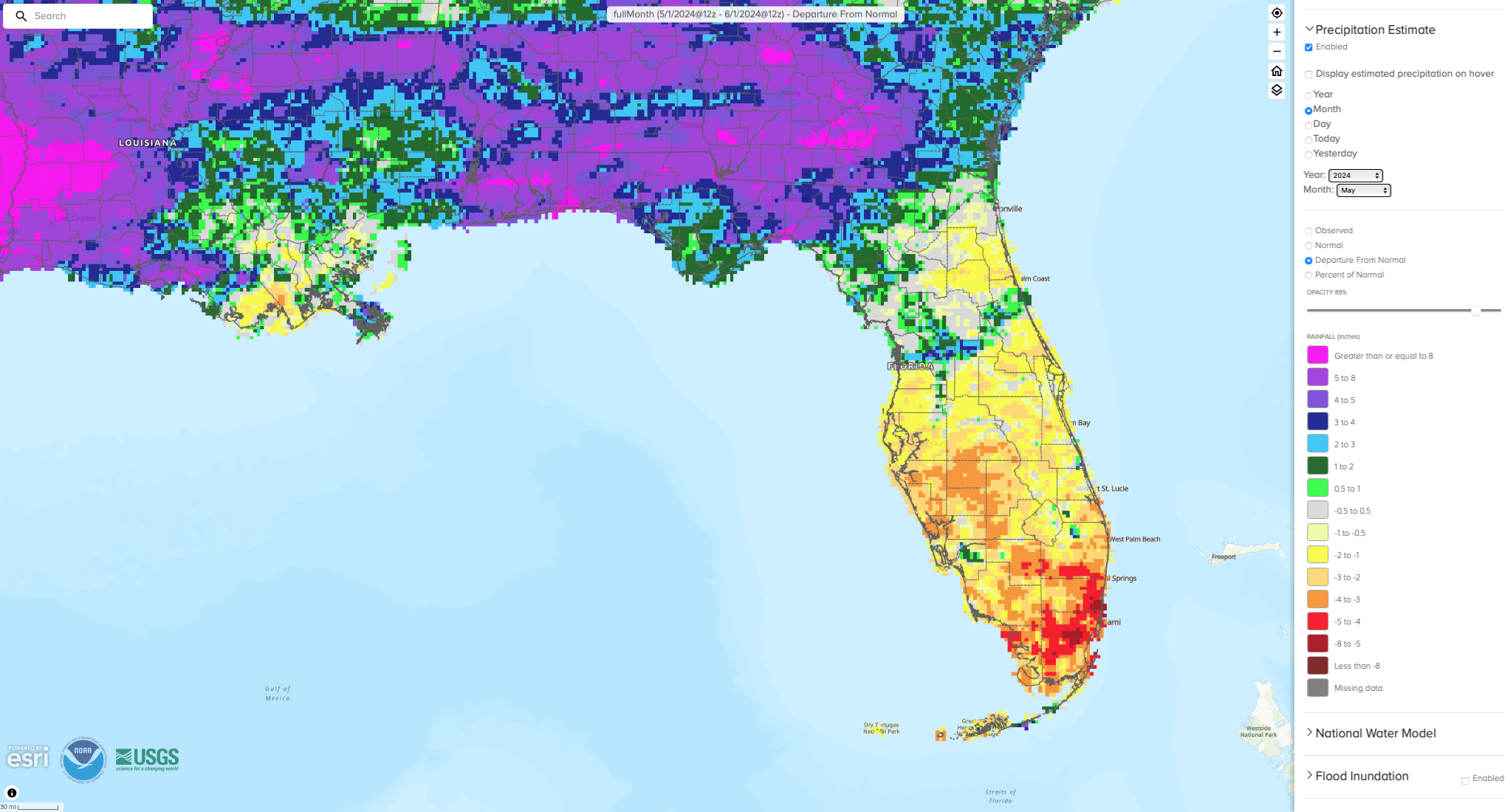
El Niño Advisory / La Niña Watch.
El Niño conditions, the warm phase of the El Niño Southern Oscillation climate pattern in the tropical equatorial Pacific Ocean, have continued to weaken. A transition to ENSO-neutral is expected within the next month. The atmospheric components of El Niño have essentially shut off, while ocean signals have weakened with some regions seeing decreased sea surface temperatures and lower Niño index values over the last month. La Niña is expected to emerge during June-August 2024 (49% chance). Chances increase to 69% deeper into summer, during July-September 2024. Historically, La Niña conditions typically follow strong El Niños, which adds to the forecast confidence.
Hazardous Weather Events in May.
According to the Local Storm Reports issued by the local National Weather Service offices serving Florida, there were 465 individual local reports of hazardous weather events recorded across the state during the month of May (see Table 4 for a breakdown by event type). An active weather pattern this month led to severe weather across the state with high winds and golf-ball sized hail leading to downed trees, downed power lines, and flash flooding. Strong storms and straight-line winds impacted parts of southwest Florida, and the Panhandle saw multiple rounds of severe weather with straight-line winds and tornadoes. This includes an outbreak in Leon and surrounding counties on May 10th, which is described in more detail below.
Table 3. Breakdown of storm reports submitted in Florida during the month of May (compiled from Iowa State University/Iowa Environmental Mesonet).
| Report Type | Number of Reports |
| Heavy Rain | 3 |
| Flood | 3 |
| Flash Flood | 18 |
| Coastal Flood | 0 |
| Hail | 51 |
| Marine Thunderstorm Wind | 41 |
| Non-Thunderstorm Wind Gust | 18 |
| Non-Thunderstorm Wind Damage | 0 |
| Tornado/Waterspout/Funnel Cloud | 8/5/8 |
| Thunderstorm Wind Damage | 103 |
| Thunderstorm Wind Gust | 201 |
| Rip Currents | 0 |
| Lightning | 1 |
| Wildfire | 5 |
Daily Record Events in May.
Table 4. Summary of daily records broken or set in Florida in May (source: NCEI Daily Weather Records).
| Category | Number of Records |
| Highest daily max. temp. | 146 |
| Highest daily min. temp. | 172 |
| Lowest daily max. temp. | 3 |
| Lowest daily min. temp. | 0 |
| Highest daily precipitation | 29 |
| Total | 350 |
Weather/Climate Highlights of the Month: May 10th Tornadoes in Leon County.
May brought an active weather pattern both in Florida and across the country. Nationally, the number of local storm reports since January 1st ranks 2nd dating back to 2010. A tornado outbreak on May 8-10 affected much of the Southeast U.S. On the morning of May 10, a squall line affected the tri-state area with 100+ mph straight-line winds and the storm spawned 5 tornadoes in the area. Three tornadoes touched down in Tallahassee in less than 30 minutes, according to the National Weather Service. The number of broken power poles from this event exceeded that from hurricanes Hermine, Michael, and Idalia combined, according to NWS and the City of Tallahassee. Over 70,000 customers were without power on Friday, and over 400 utility poles were downed. In addition to damage to utility structures, numerous trees were broken, homes damaged, and businesses affected, including FSU, FAMU, and the Railroad Square district.
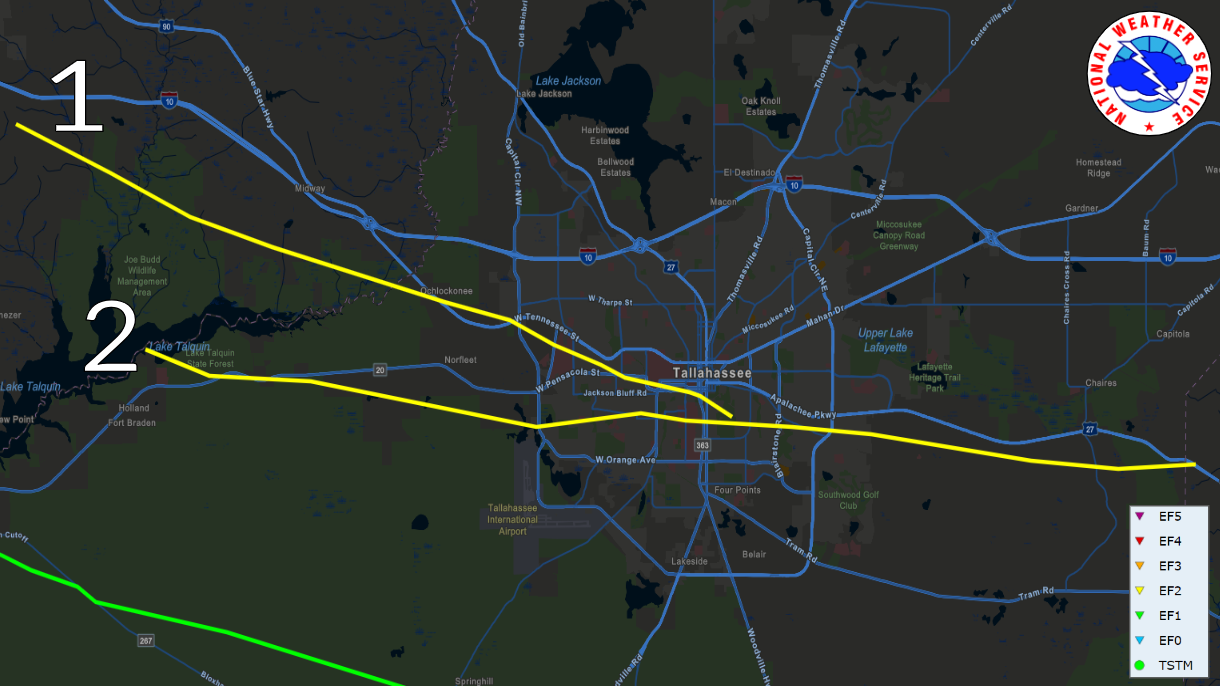
The first tornado path shown in the image above was rated an EF2. It was on the ground for nearly 20 miles with peak wind speeds of 115 mph. The second tornado was also rated EF2 and was on the ground for 27 miles. These two tornadoes converged at the Capital City Country Club in Tallahassee, where the second tornado became the dominant circulation moving on toward the east. A third tornado, rated EF1 (shown in the bottom left of the image above) moved across southern Leon County in Woodville with a path length of nearly 32 miles and peak wind speeds of 110 mph. Three other tornadoes, including an EF1 and two EF0s touched down in surrounding counties. Read more about the storm and damages from the Tallahassee National Weather Service office here: https://www.weather.gov/tae/2024_05_Tornadoes.
Drought-Related Impacts.
By mid-May, approximately 16% of the state was experiencing moderate drought (D1) conditions and 22% of the state was abnormally dry (D0), according to the U.S. Drought Monitor. Drought expansion and degradation occurred by the end of the month, with 4% of the state in severe drought (D2), 30% in moderate drought (D1), and 11% abnormally dry (D0) (see Figure 3 below). As of the end of the month, 13 counties in central and southern Florida had outdoor burn bans in place, and wildfires broke out during the month across these regions.
As of May 31, the Lake Okeechobee water level was 12.97 ft. above sea level (Feet-NGVD29), which is just below average for this time of year. At the first of the month, the water level was 14.18 ft. above sea level.
Figure 2. A graphical depiction of the latest drought conditions in Florida according to the U.S. Drought Monitor (courtesy of the National Drought Mitigation Center, University of Nebraska-Lincoln).
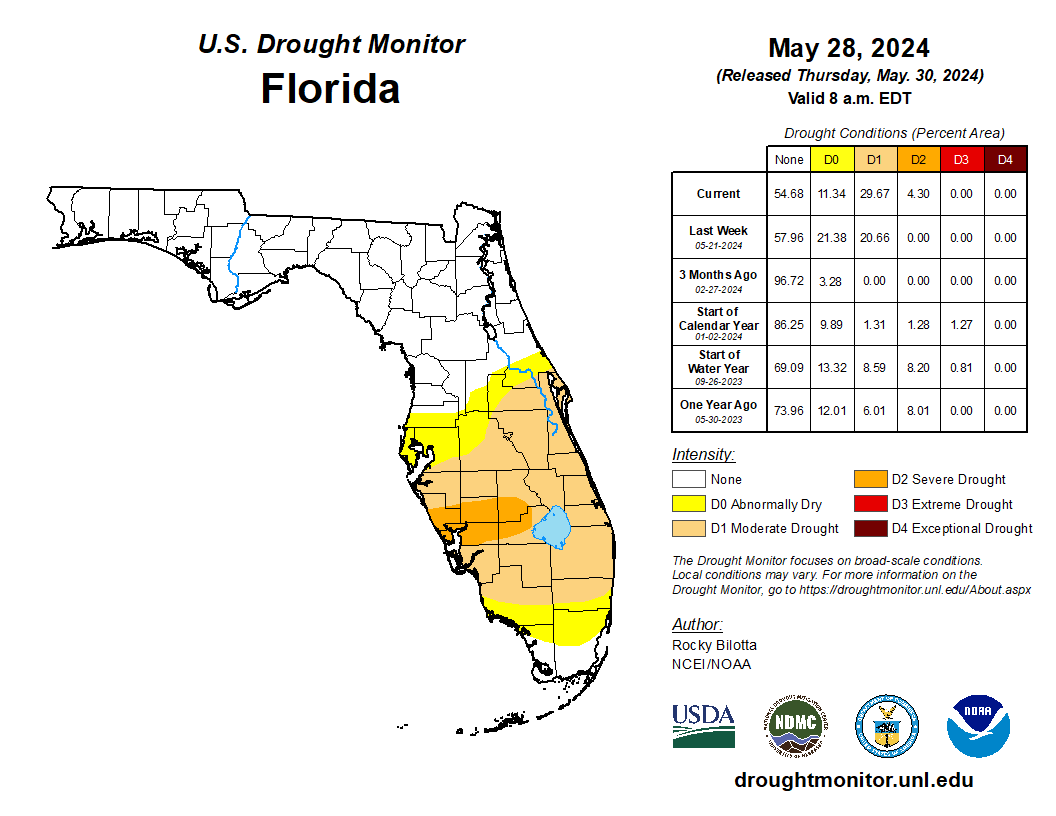
Agriculture-Related Impacts.
In mid-May, topsoil moisture conditions were adequate in 71% of the state, short in 23%, and very short in 5% of the state, while 1% of the state had surplus topsoil moisture conditions. Near the end of May, topsoil moisture conditions were adequate in 65% of the state, short in 23%, and very short in 7% of the state; 5% of the state was in surplus conditions. While much of the Southeast region has grappled with wet conditions, drought is beginning to affect the main citrus belt region in Florida with daily irrigation needed. For more information, consult the Crop Progress and Conditions report, which is published by the USDA’s National Agricultural Statistics Service.
Appendix 1
Additional May departures from normal data for select Florida locations (Source: NWS).
| Station | Average Temperature (˚F) | Departure from Normal (˚F) | Total Rainfall (in.) | Departure from Normal (in.) |
| Gainesville | 77.4 | +2.4 | 1.59 | -1.49 |
| Sarasota | 81.4 | +3.6 | 0.02 | -2.56 |
| Naples | 83.0 | +4.2 | 0.72 | -2.04 |
| Fort Myers | 83.2 | +3.9 | 3.83 | +0.37 |
| West Palm Beach | 84.2 | +5.5 | 1.18 | -3.73 |
Appendix 2
Select daily record high maximum temperatures (°F) broken during May (compiled from NOAA).
| Location | Date | Record | Broken/Tied | Last |
| Orlando | 8 | 96 | Broken | 95 in 2009 |
| Jacksonville | 8 | 97 | Broken | 95 in 2009 |
| Clermont | 9 | 97 | Broken | 96 in 2009 |
| Deland | 9 | 97 | Broken | 96 in 1916 |
| Plant City | 9 | 100 | Broken | 96 in 1955 |
| Orlando | 9 | 97 | Broken | 95 in 2009 |
| Daytona Beach | 9 | 97 | Broken | 94 in 1978 |
| Tallahassee | 9 | 96 | Broken | 95 in 2015 |
| Jacksonville | 9 | 99 | Broken | 95 in 2009 |
| Hialeah | 10 | 96 | Broken | 94 in 1998 |
| Vero Beach | 10 | 96 | Broken | 92 in 1998 |
| Fort Lauderdale | 11 | 96 | Broken | 93 in 2008 |
| West Palm Beach | 11 | 97 | Broken | 95 in 2011 |
| Key West | 11 | 94 | Broken | 90 in 2019 |
| Homestead | 13 | 96 | Broken | 93 in 2021 |
| Fort Lauderdale | 14 | 96 | Broken | 94 in 1971 |
| Key West | 15 | 92 | Broken | 90 in 1991 |
| West Palm Beach | 15 | 98 | Broken | 94 in 1995 |
| Fort Lauderdale | 16 | 96 | Broken | 94 in 1995 |
| Homestead | 17 | 97 | Broken | 92 in 2022 |
| Hialeah | 18 | 96 | Broken | 93 in 1989 |
| Orlando | 18 | 96 | Broken | 95 in 1981 |
| Fort Lauderdale | 19 | 98 | Broken | 94 in 2008 |
| West Palm Beach | 19 | 98 | Broken | 94 in 2008 |
| Miami | 19 | 96 | Broken | 94 in 1995 |
| Homestead | 20 | 100 | Broken | 93 in 2008 |
| Bradenton | 25 | 98 | Broken | 94 in 2015 |
| Bradenton | 26 | 97 | Broken | 95 in 1975 |
| Homestead | 26 | 98 | Broken | 92 in 1999 |
| Miami | 26 | 96 | Broken | 94 in 1949 |
| Homestead | 26 | 98 | Broken | 92 in 1999 |
| Miami | 26 | 96 | Broken | 94 in 1949 |
| Archbold Bio Stn | 27 | 100 | Broken | 99 in 2000 |
| Fort Lauderdale | 27 | 99 | Broken | 94 in 1924 |
| Homestead | 27 | 98 | Broken | 93 in 1999 |
| Fort Pierce | 28 | 97 | Broken | 95 in 1973 |
| West Palm Beach | 28 | 99 | Broken | 93 in 2017 |
| Stuart | 29 | 97 | Broken | 95 in 1973 |
| Bradenton | 30 | 100 | Broken | 95 in 2005 |
| Clermont | 30 | 100 | Broken | 98 in 2019 |
| Homestead | 30 | 98 | Broken | 92 in 2017 |
| Tampa | 30 | 98 | Broken | 96 in 2022 |


